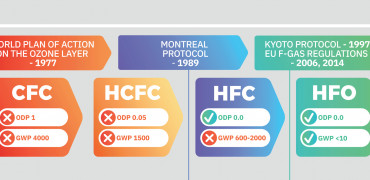The number of well-known corporate names adding their weight to the shift to a low carbon economy is growing at a weekly rate.
Just recently, environmental business edie.net reported that Tate & Lyle had its environmental and emissions goals approved by the Science Based Targets Initiative.
Computer specialist Lenovo made a similar move in early September when it announced that it would reach net zero emissions by 2050.
TV channel ITV has also recently committed to net-zero by 2030, and coffee company Nespresso is aiming for carbon neutrality by 2022.
Adopting new HVAC approaches can help to reach sustainable goals.
Sustainable goals
The challenge for large corporations is to reduce carbon across a broad range of operations - including their buildings.
From offices to manufacturing sites, to laboratories – each will have their energy performance profiles and requirements for services such as heating and cooling.
Building services have a significant impact on the energy use and related carbon footprint of any business.
Adopting new approaches to meeting requirements for heating, cooling and ventilation can help to reach sustainable goals.
It can also enhance system performance and make for a healthier indoor climate for occupants.
Going Hybrid
Mitsubishi Electric has spent some years exploring new approaches to delivering HVAC into buildings. Our philosophy has been to build on familiar and reliable technologies, but adding aspects of design and performance that create benefits in the short- and long-term.
For example, the Mitsubishi Electric Hybrid VRF (H-VRF) system builds on the familiar VRF approach to delivering simultaneous heating and cooling into a building.
However, the 'Hybrid' element is what makes the system different.
An external Hybrid Branch Controller (HBC) contains the R32 refrigerant for the system, but heating and cooling are delivered to interior fan coil units using water as the medium.
The result is a system designed, and operated, just like a VRF system, but which uses a fraction of the refrigerant.
What's more, since there is no R32 refrigerant in an occupied space, there is no requirement for leak detection – saving installation time and costs.
Heat recovery chillers
Chillers are another well-known element of the HVAC system in buildings. Mitsubishi Electric’s Integra chiller offers this familiar technology that also includes heat recovery within the chiller itself – making it a great option where space is at a premium.
While heat recovery isn't a new idea, its application in a simultaneous heating and cooling chiller is a fresh take on saving energy and reducing the carbon footprint.
It works well in offices where heating and cooling may be required in different parts of the building; or mixed-used developments of offices and apartment dwellings. The heat extracted can also be used to supplement hot water, reducing the load on boilers.
Cutting fossil fuel use
Many businesses are looking to reduce their reliance on fossil fuels, and adopting an electric approach to heating using heat pumps is one way to do this.
Heat pumps are excellent for delivering low carbon, high-efficiency, low-temperature heating. However, they have usually required additional use of boilers for the production of hot water.
With this in mind, Mitsubishi Electric has recently launched its Ecodan QAHV heat pump.
The QAHV produces hot water from 55oC to 90oC. Not only does it offer high-efficiency heating, but the QAHV also removes the need for boilers to boost hot water production – saving capital expenditure and long-term energy costs.
Here to help
The development of new technologies in HVAC is keeping pace with the demand from clients for new approaches to familiar challenges.
Spaces need to be cooled, ventilated and heated. Hot water is required.
We can meet these needs in new ways with no compromise on performance or delivery – supporting clients and their sustainable goals.
James Smurthwaite, Business Development Manager



